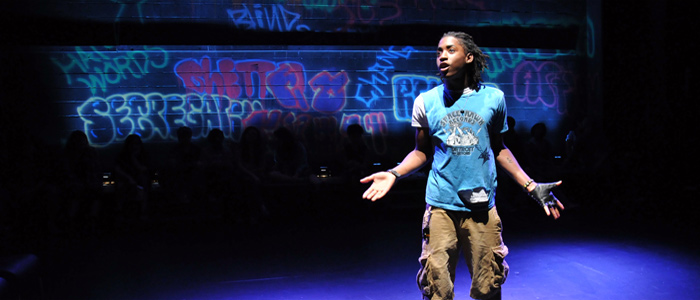“My friends and I were on the phone until 2:00 a.m. after the show.” “Rather than worry about where we were going to eat as usual, my family and I talked about the play’s issues for 3 1/2 hours afterwards.” “My French teacher spent the whole class on Monday talking about it.” “At prom, my friends were discussing it.”
When they began the process of creating a new work, drama students had no idea how it would turn out. They were primarily Level I and II students, creating a play from scratch, for the first time, and using a completely new technique to do so. Yet they found a way to address issues central to New Orleans and the country.
The result is Se-Pa-Rate, a series of moments which takes its cue from Plessy v. Ferguson, the landmark 1896 U.S. Supreme Court decision upholding public segregation under the doctrine of “separate but equal.” Homer Plessy, in an act of civil disobedience designed by the Citizen’s Committee to challenge segregation, boarded a train on what is now NOCCA’s parking lot, to be arrested two blocks down on Royal Street. Students determined to examine how issues of segregation still affect them today. Woven into historical events are moments students created from their own experiences and through the techniques taught in a master workshop with Tectonic Theatre Project.
Through the support of a Field of Interest grant from the Greater New Orleans Foundation, Theatre Arts Chair Dan Zimmer sought to expand the professional training experiences of students. He brought in Andy Parris, a founding member of the acclaimed New York company, best known for its groundbreaking play and HBO production, The Laramie Project.
“Ninety-nine percent of the time, when people describe their favorite moment in a play or movie, there is no text,” Parris pointed out to students. “What strikes us are things that are happening. That doesn’t mean that text isn’t important. It is. It just doesn’t contain the full story.”
Over the course of a week, students learned to use all the elements of stage in creating hundreds of one-minute moments, including lights, space, time, sound, props, scenery, movement, energy, voice, color, emotion, line, music and so much more. “Using these forms helps you find the story.”
So, without a script, but with new tools and a chosen subject – segregation – the students began their journey. Drama teacher Silas Cooper determined they should break up into cliques. Initial discussions were very difficult and highly defensive. “We had heated arguments, but we weren’t necessarily listening to each other,” says student Celeste Cahn.
Nonetheless, they started to create 60 – 70 moments based on themes they were discussing: how they segregated themselves by race, by uniform, by type of school, by RSD vs. OPS school, by sexual orientation, by religion, by what music they liked, by which parent lived better after a divorce, whether they were in the main program at NOCCA or afterschool. And they researched Plessy v. Ferguson as well as discriminatory tests of the day, such as the pencil test in the hair or paper bag test for skin tone.
They returned for a second round of discussions (all filmed as part of the project’s archive). Cooper constantly had students reintegrate into different groups, each day, each hour. “I never talked about serious things, only happy things. I didn’t want to rock the boat. But that changed over time,” says Kalen Oubre. “Finally we came to the point where students had to decide what they had the courage to say in public,” explains Cooper. It was time to put all of their moments together, flanked by the historical facts of Plessy’s arrest.
“I didn’t expect people would absorb it as much as they did,” offered Arianne Newman. “I realize how much segregation comes into everything I do. I was taking a history test with a question about Plessy v. Feguson and I found myself thinking, ‘Every day for six weeks from 4 – 6 p.m. we have been working on this, and now I have to come up with just one sentence? Impossible.’” “The process made me look at people a lot differently,” says Kevin Pollard; “I would defend them now, not laugh at someone.” Donovan Lockett continued, “it fostered acceptance and understanding that all of our stories count.” Yet, as Josh LeCoq pointed out, “we don’t intend for the play to force our views on anyone, we just want to give you something to think about.”
“Allowing people to disagree in the beginning made you able to see the other side,” insightfully notes Angela Stewart, when asked how students were able to find a way to work through a part of the human condition that most holds us back. NOCCA’s highly diverse student body, which comes from 120 sending schools and every economic and cultural background, also allowed for so many stories to be told. “The issue of segregation doesn’t change,” points out Silas Cooper, “just who is it.”
Se-Pa-Rate is still a work in progress. Faculty and students will work to refine the production and hope to take it on the road in the upcoming school year. It is a format that can grow as students grow, as new students and new voices enter the program. In the end, students became closer than in any other production. Concluded Kalen, “it is not just a play anymore, it is a lifestyle. It changed me.”

